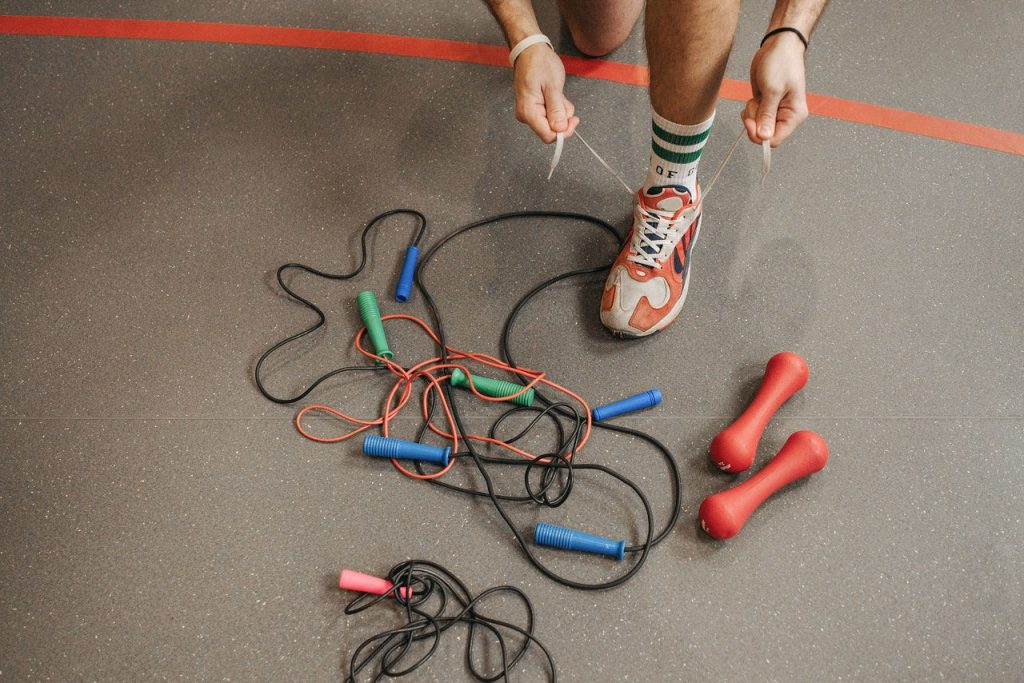Jumping rope is a very effective aerobic exercise as it affects your entire body from the upper part to the lower part of your body. It creates moderate pressure on your hips, ankles, and knees. Jumping rope is an easy approach to lose weight and tone your calf muscle and forearms. Apart from that, it also strengthens your bones. According to the study of the United Kingdom Osteoporosis Society, jumping ropes decelerate bone decay with aging, thereby reducing the risk of having osteoporosis in the future. However, every positive thing has few adverse outcomes, and it is applicable for jumping rope too. Though this exercise is good for your body, you may sometimes come across jump rope injuries. We suggest you read about some typical jump rope injuries before starting that. Therefore, you may avoid and manage those injuries without any hurdles.

Seven Common Jump Rope Injuries You Must Aware Of
SHIN SPLINTS
It is one of the very familiar jump rope injuries which impacts the body part around the shinbone. Therefore, you may feel pain between the ankle and knee. These injuries usually occur while playing basketball, football, racquetball, and table tennis. Some of the symptoms of shin splints are pain after moderate to high exercise, numb or frail feet, shin bone pain, muscle pain, and pain on the lower part of the legs.
How to prevent shin splints
To prevent shin splints, you must wear fitting shoes when jumping rope. Before skipping rope:
- Follow some warm-up exercises to boost muscles.
- Don’t ever jump the rover continuously.
- Avoid jumping so high.
ANKLE PAIN
The second most common rope injury is ankle pain. Ankle pain develops when you dislocate your ankle. If your ankles get twisted, the ligaments easily tear. You may see initial bruising and swelling on the ankle. Thus you should not jump rope in this particular condition as you may feel immense discomfort. You may notice swelling on your knees, skin discoloration, along with ankle pain.
How to avoid ankle pain
Don’t skip rope with high-heel shoes. Avoid concrete surfaces. Also, do not perform jumping rope when you may feel tired. You must do some warm-up exercises before jumping rope for better movement.
BUNIONS
Bunions are a prevalent rope injury. They develop in the form of inflammation around the bigger toe. Bunions develop when you skip rope with long height or wear small shoes or shoes that will not wear out. Bunions also take place when you stand for a prolonged period of time.
A bunion is very painful and causes permanent toe deformity. Some symptoms of the bunions are the inability to move your feet. This pain can be excruciating on your feet which may appear and vanish. The side of your big toe may be turned red, and some thick skin appears beneath the bigger toe.
How to Prevent Bunions
If you want to avoid bunions, wear padded sole shoes while jumping rope. Place your feet in a straight posture while jumping rope. You have to remember that if you develop a big lump under the big toe, that is the signal to take the doctor’s assistance.
HEEL SPURS
The fourth common jump rope injury is heel spurs. They do not appear instantly after physical activity but develop over some time. Experts also reported that walking and running on hard or irregular surfaces cause heel spurs. Thus, they recommend wearing well-fitted shoes while doing physical exercise.
How to Prevent Bunions
Take ankle support with your shoe. You may even wear orthotic shoe inserts. To avoid pain and inflammation, take anti-inflammatory injections. You could also take cold compression on the affected area and relax your feet after jumping rope for a minimum of 10 minutes. Do some stretches at night before sleep to boost recovery. Do not wear flip-flops very often.
TURF TOE
It develops while an individual suddenly bends their big toe while jumping rope. Football players, wrestlers, basketball players, and ballet dancers come across the Turf toe injury as these kinds of activities are performed on the hard surface and exert whole body weight on the big toe.
How to prevent TURF TOE
Apply cold compression at the affected area to alleviate the inflammation and pain. If you have an injury, stop jumping rope until you have entirely recovered.
CALF STRAIN (EXCESSIVE SORENESS)
Your calf is present at the back of your leg below the knee. It may happen to experience a calf strain after jumping rope. Along with calf strain, you may experience intense pain and tear sensation. With increasing pain, you will develop swelling and bruising.
How to avoid a calf strain
Follow your warm-up routine. Do some jogging, walk and stretch your calf muscles to make them flexible. Also slows down in the last 10 minutes prior to completely pausing jumping rope.
STRESS FRACTURES
A stress fracture is a small crack in a bone. It appears on the weight-bearing bone on the lower part of your leg and foot. If you suffer from a stress fracture, you will definitely experience swelling and tenderness around the affected area.
How to prevent stress fractures:
When you start jumping rope, increase the frequency gradually, and do not forget to wear perfect shoes. You may add some low-impact exercise like Cross-training to prevent stressing the muscle extensively.
You can also follow the above-mentioned preventive measures to avoid injuries while skipping rope. Don’t forget to improve handgrip strength to hold both rope handles tightly.




Skipping wire or we can say that Jumping row workout is very important thing for everyone. Just before 20 days i started and lose around 3 kg of weight by doing 600 skipping per day, which is very effective for me. Also sometimes taking help of Creatine can help to improve more energy.